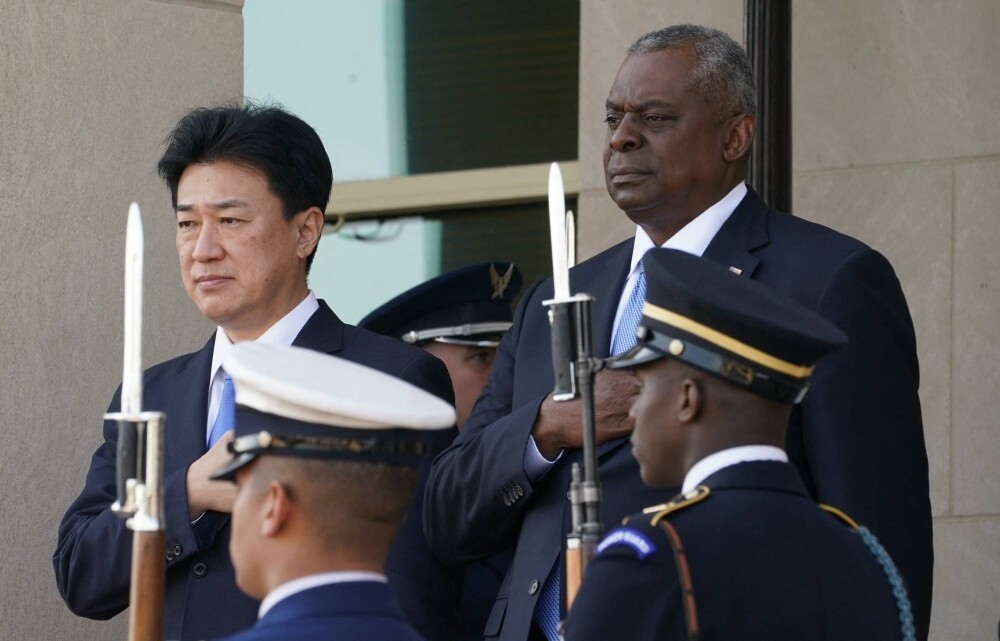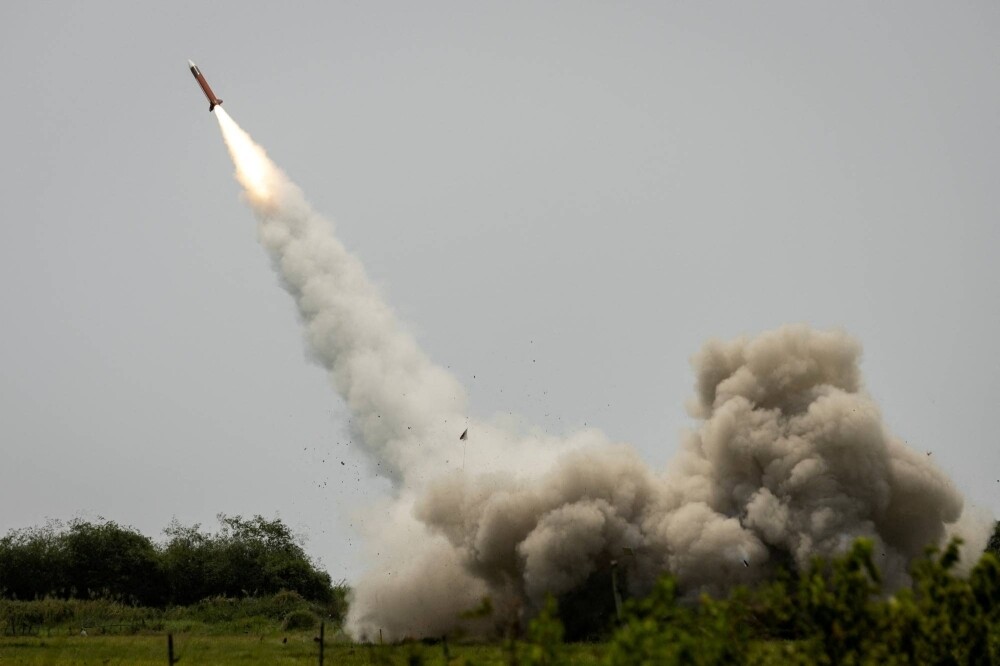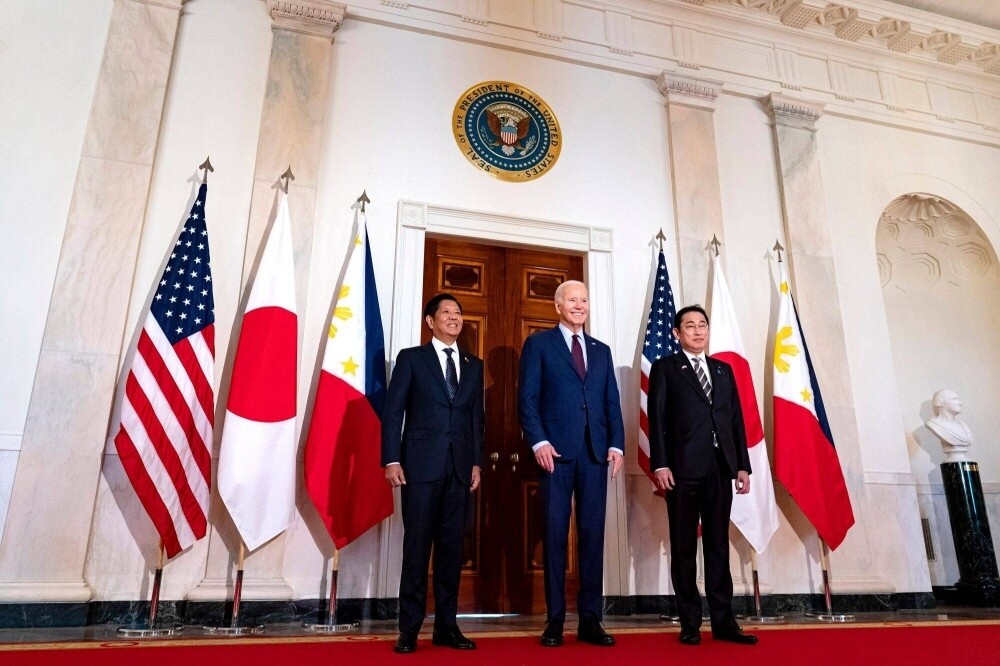‘Collective capacity’ to top agenda at four-way defense talks in Hawaii
BY GABRIEL DOMINGUEZ
STAFF WRITER
SHARE
Apr 30, 2024
When Defense Minister Minoru Kihara travels to Hawaii on Thursday for three days of talks with his U.S., Australian and Philippine counterparts, there will be one thing on his mind: how to deepen military and security cooperation to counter China.
“Through this visit, I hope to send a strong message of unity among allies and like-minded countries toward the realization of a rules-based international order and a free and open Indo-Pacific,” Kihara told a news conference Friday.
The gathering comes as Washington continues to bring regional allies and partners closer together in small groupings to build up what it calls “collective capacity.”
While specifics have yet to be revealed, Kihara will join U.S. Secretary of Defense Lloyd Austin, Philippine defense chief Gilberto Teodoro and Australian Defense Minister Richard Marles to discuss the regional security situation, common challenges and a wide range of initiatives to strengthen multilateral cooperation.
High on the agenda are likely to be steps to follow up on the countries’ first-ever joint naval exercises in the disputed South China Sea earlier this month.
Ostensibly intended to safeguard “the rule of law” and uphold freedom of navigation and overflight in the region, these joint activities are mainly seen as a show of force to deter Chinese aggression in contested waters in response to indications of the emergence of the new U.S.-led, quadrilateral security grouping in the region.
Besides partaking in the four-way discussions — the second since last June — Kihara will hold bilateral talks with Austin and Marles and join a trilateral meeting with both, possibly with an eye on further integrating bilateral and trilateral logistics.
A Patriot air missile system is fired during a live-fire exercise part of the annual Balikatan, or shoulder-to-shoulder, joint military exercises between U.S. and Philippine troops at a naval base in San Antonio, the Philippines, on Thursday. | REUTERS
Analysts point out, however, that the Kihara-Austin meeting is unlikely to result in concrete deliverables on some of the announcements made during this month’s U.S.-Japan leaders’ summit, including plans to expand the functions of the U.S. military’s command in Japan and explore ways to deepen defense-industrial cooperation.
Those issues, they say, are more likely to be discussed in detail at a meeting this summer between the countries’ defense chiefs and top diplomats that will also focus on enhancing U.S. extended deterrence, including through Japan’s growing defense capabilities.
The four ministers will also attend a change-of-command ceremony in Hawaii on Friday, as Adm. Samuel Paparo takes the reins from Adm. John Aquilino as the new head of the U.S. military’s Indo-Pacific Command.
But the selection of Hawaii as the meeting locale also carries symbolic meaning.
“Hawaii, as a midpoint rather than Washington, is suggestive not only in terms of diplomatic logistics, but also in emphasizing that the Indo-Pacific will be their main focus,” said Masashi Murano, a U.S.-based Japan chair fellow at the Hudson Institute think tank.
By grouping regional allies, U.S. President Joe Biden hopes to reduce redundancies and coordination challenges in bilateral security ties amid shared regional security concerns.
“They are trying to strengthen the alliance network by vitalizing multiple bilateral and trilateral frameworks,” Murano said, noting that the U.S.-led regional security architecture is now becoming a “lattice-like framework” centered on the United States and Japan, rather than a “hub-and-spokes” framework with the U.S. as the hub.
Highlighting such efforts was a trilateral summit held earlier this month between Biden, Prime Minister Fumio Kishida and Philippine leader Ferdinand Marcos Jr. at the White House. The summit, the first of its kind, resulted in several security agreements, including plans to conduct more four-way naval patrols alongside Australia, including one next year around Japan.
“From a strategic perspective, having these allies together to discuss common security challenges sends a strong signal of unity to China that the U.S. has like-minded partners,” said Jeffrey Hornung, a senior political scientist and Japan lead at the Rand Corp.
Philippine leader Ferdinand Marcos Jr., U.S. President Joe Biden and Prime Minister Fumio Kishida arrive for a trilateral meeting at the White House in Washington on April 11. | BLOOMBERG
Tokyo, Manila and Canberra — all U.S. allies well aware of the difficulties surrounding deterring an increasingly powerful China — have backed this collective approach.
The goal, experts say, is to “institutionalize collaboration as quickly as possible” and make it part of the fabric of how each country’s national security establishments do business, with maritime security being the natural place to start.
The Philippines plays a key strategic role in these calculations. Its proximity to both Taiwan and key sea lanes in the resource-rich South China Sea makes it an attractive staging point for the U.S. and its allies that could boost their ability to respond to regional crises.
Given the intensifying regional maritime disputes, specific action plans will likely include increasing the scope and frequency of joint training, maritime patrols and the rotational deployment of troops, all the while enhancing logistics.
To facilitate this, Japan is planning to sign a visiting-forces agreement with the Philippines later this year. Washington and Canberra signed similar deals with Manila in 1998 and 2007, respectively.
The upcoming meetings could also examine ways to increase the number of U.S. and Japanese assets involved in joint exercises, with Murano saying that Washington and Tokyo may send maritime patrol aircraft in the future.
The focus could also be on whether naval operations will be carried out in areas outside the Spratly Island chain of the South China Sea, and how often.
Discussions on the deployment of U.S. midrange missile systems to the region are also expected, after Washington temporarily dispatched its Typhon system — capable of launching Tomahawk and SM-6 missiles — to the Philippines as part of a joint exercise.
Such a move would have been difficult to accept for former Philippine President Rodrigo Duterte, even if only temporarily.
But the Marcos administration’s decision to be the first in the region to accept these types of weapons may have lowered the political and psychological hurdles for such deployments to other countries, including Japan, he added.
“The political burden of deploying these weapons may not be as unfairly heavy now, since governments could argue that the burden would be shared by all regional allies, not just one particular country,” Murano said.
While multilateral activities are intensifying, each of these countries has also been separately strengthening bilateral ties with Manila.
Tokyo recently completed delivery of two of the four air surveillance radars Manila bought in a 2020 intragovernmental deal for $98.7 million, with the final two systems now slated for delivery by 2026.
Japan will also deliver five maritime surveillance radars under a new military aid program launched last year.
“The allies intend to contain Beijing’s threats through networking,” said Masashi Okuyama, a visiting professor at Tama University. “The problem, however, is that no one knows how seriously Chinese leader Xi Jinping is taking this.”
Consequently, experts question whether the latest multilateral efforts will be enough to deter China, which has already criticized the upcoming Hawaii defense chiefs’ meeting as “exacerbating regional risks.”
“I don’t think China will immediately stop all its aggressive activities in the East and South China seas because of meetings such as the one that is scheduled to take place,” said Naoko Aoki, an associate political scientist at the Rand Corp.
“But the point here is to try to influence Beijing’s calculations about what it can get away with in those areas.”
KEYWORDS
MINORU KIHARA, DEFENSE MINISTRY, DEFENSE, CHINA, AUSTRALIA, PHILIPPINES, SOUTH CHINA SEA, U.S. MILITARY, LLOYD AUSTIN, INDO-PACIFIC, U.S.


